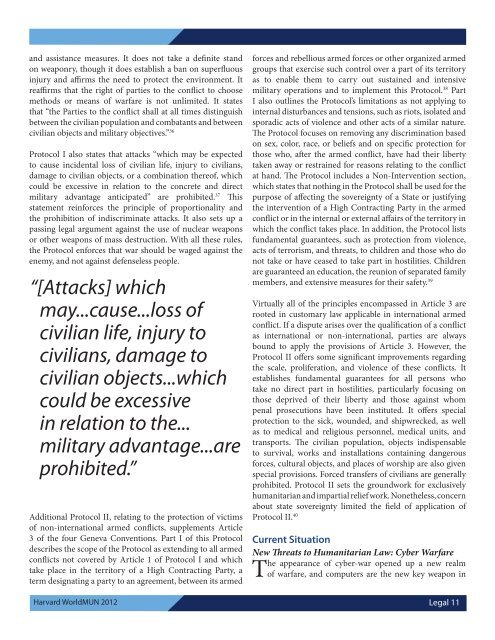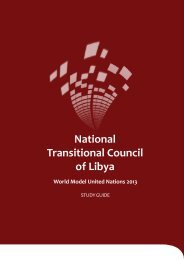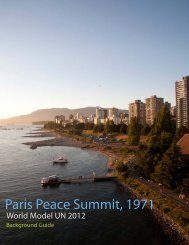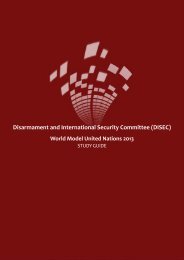Legal Committee - World Model United Nations
Legal Committee - World Model United Nations
Legal Committee - World Model United Nations
Create successful ePaper yourself
Turn your PDF publications into a flip-book with our unique Google optimized e-Paper software.
and assistance measures. It does not take a definite stand<br />
on weaponry, though it does establish a ban on superfluous<br />
injury and affirms the need to protect the environment. It<br />
reaffirms that the right of parties to the conflict to choose<br />
methods or means of warfare is not unlimited. It states<br />
that “the Parties to the conflict shall at all times distinguish<br />
between the civilian population and combatants and between<br />
civilian objects and military objectives.” 36<br />
Protocol I also states that attacks “which may be expected<br />
to cause incidental loss of civilian life, injury to civilians,<br />
damage to civilian objects, or a combination thereof, which<br />
could be excessive in relation to the concrete and direct<br />
military advantage anticipated” are prohibited. 37 This<br />
statement reinforces the principle of proportionality and<br />
the prohibition of indiscriminate attacks. It also sets up a<br />
passing legal argument against the use of nuclear weapons<br />
or other weapons of mass destruction. With all these rules,<br />
the Protocol enforces that war should be waged against the<br />
enemy, and not against defenseless people.<br />
“[Attacks] which<br />
may...cause...loss of<br />
civilian life, injury to<br />
civilians, damage to<br />
civilian objects...which<br />
could be excessive<br />
in relation to the...<br />
military advantage...are<br />
prohibited.”<br />
Additional Protocol II, relating to the protection of victims<br />
of non-international armed conflicts, supplements Article<br />
3 of the four Geneva Conventions. Part I of this Protocol<br />
describes the scope of the Protocol as extending to all armed<br />
conflicts not covered by Article 1 of Protocol I and which<br />
take place in the territory of a High Contracting Party, a<br />
term designating a party to an agreement, between its armed<br />
forces and rebellious armed forces or other organized armed<br />
groups that exercise such control over a part of its territory<br />
as to enable them to carry out sustained and intensive<br />
military operations and to implement this Protocol. 38 Part<br />
I also outlines the Protocol’s limitations as not applying to<br />
internal disturbances and tensions, such as riots, isolated and<br />
sporadic acts of violence and other acts of a similar nature.<br />
The Protocol focuses on removing any discrimination based<br />
on sex, color, race, or beliefs and on specific protection for<br />
those who, after the armed conflict, have had their liberty<br />
taken away or restrained for reasons relating to the conflict<br />
at hand. The Protocol includes a Non-Intervention section,<br />
which states that nothing in the Protocol shall be used for the<br />
purpose of affecting the sovereignty of a State or justifying<br />
the intervention of a High Contracting Party in the armed<br />
conflict or in the internal or external affairs of the territory in<br />
which the conflict takes place. In addition, the Protocol lists<br />
fundamental guarantees, such as protection from violence,<br />
acts of terrorism, and threats, to children and those who do<br />
not take or have ceased to take part in hostilities. Children<br />
are guaranteed an education, the reunion of separated family<br />
members, and extensive measures for their safety. 39<br />
Virtually all of the principles encompassed in Article 3 are<br />
rooted in customary law applicable in international armed<br />
conflict. If a dispute arises over the qualification of a conflict<br />
as international or non-international, parties are always<br />
bound to apply the provisions of Article 3. However, the<br />
Protocol II offers some significant improvements regarding<br />
the scale, proliferation, and violence of these conflicts. It<br />
establishes fundamental guarantees for all persons who<br />
take no direct part in hostilities, particularly focusing on<br />
those deprived of their liberty and those against whom<br />
penal prosecutions have been instituted. It offers special<br />
protection to the sick, wounded, and shipwrecked, as well<br />
as to medical and religious personnel, medical units, and<br />
transports. The civilian population, objects indispensable<br />
to survival, works and installations containing dangerous<br />
forces, cultural objects, and places of worship are also given<br />
special provisions. Forced transfers of civilians are generally<br />
prohibited. Protocol II sets the groundwork for exclusively<br />
humanitarian and impartial relief work. Nonetheless, concern<br />
about state sovereignty limited the field of application of<br />
Protocol II. 40<br />
Current Situation<br />
New Threats to Humanitarian Law: Cyber Warfare<br />
The appearance of cyber-war opened up a new realm<br />
of warfare, and computers are the new key weapon in<br />
Harvard <strong>World</strong>MUN 2012 <strong>Legal</strong> 11

















